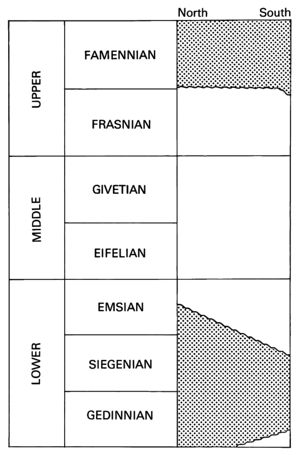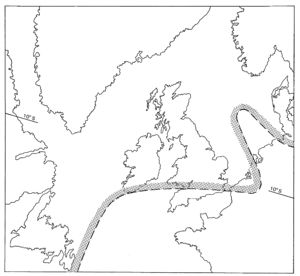Introduction to the Devonian, Midland Valley of Scotland: Difference between revisions
BobMcIntosh (talk | contribs) No edit summary |
m (Text replacement - "'''From: Cameron, I B, and Stephenson, D. 1985. British regional geology: The Midland Valley of Scotland. Third edition. Reprint 2014. Keyworth, Nottingham: British Geological Survey.'''" to "{{MVRG}}") |
||
| (2 intermediate revisions by 2 users not shown) | |||
| Line 1: | Line 1: | ||
{{MVRG}} | |||
==Introduction== | ==Introduction== | ||
The Devonian rocks were laid down in an internal basin within a large continent. The basin lay between the mountains of the Caledonian Orogeny in the north and the newly formed Southern Uplands in the south. The sediments are of continental facies and are associated with extensive piles of andesitic and basaltic lavas. Vigorous erosion in the source areas to the north and south of the basin provided abundant detritus which was deposited in mountain-front fans and farther distributed by braided-river systems. | [[File:P915517.jpg|thumbnail|Devonian stages and their representation in the Midland Valley. P915517.]] | ||
[[File:P915518.jpg|thumbnail|Palaeolatitude during the Lower Devonian (after Smith and others, 1981) and approximate limit of continental facies. P915518.]]The Devonian rocks were laid down in an internal basin within a large continent. The basin lay between the mountains of the Caledonian Orogeny in the north and the newly formed Southern Uplands in the south. The sediments are of continental facies and are associated with extensive piles of andesitic and basaltic lavas. Vigorous erosion in the source areas to the north and south of the basin provided abundant detritus which was deposited in mountain-front fans and farther distributed by braided-river systems. | |||
The system is subdivided into Lower, Middle and Upper Devonian, but in the Midland Valley the Middle Devonian is not known to occur. The term Old Red Sandstone has been applied to Devonian rocks of continental facies and distinguishes them from the marine facies of south-west England and Europe. | The system is subdivided into Lower, Middle and Upper Devonian, but in the Midland Valley the Middle Devonian is not known to occur. The term Old Red Sandstone has been applied to Devonian rocks of continental facies and distinguishes them from the marine facies of south-west England and Europe. | ||
| Line 13: | Line 14: | ||
The Devonian rocks of the Midland Valley contain a fauna consisting of fish, rare arthropods and a flora which has yielded few good fossil plants but some assemblages of spores have been recorded which are valuable in broad scale correlation. The fauna is peculiar to a terrestrial environment and direct comparison with marine Devonian successions elsewhere is very difficult. The general correlation of the Midland Valley succession with marine Devonian successions is shown on [[Media:P915517.jpg|P915517]]. | The Devonian rocks of the Midland Valley contain a fauna consisting of fish, rare arthropods and a flora which has yielded few good fossil plants but some assemblages of spores have been recorded which are valuable in broad scale correlation. The fauna is peculiar to a terrestrial environment and direct comparison with marine Devonian successions elsewhere is very difficult. The general correlation of the Midland Valley succession with marine Devonian successions is shown on [[Media:P915517.jpg|P915517]]. | ||
The palaeolatitude of the Midland Valley in the Lower Devonian and its position relative to the limits of the marine and continental facies of the Devonian are shown in [[Media:P915518.jpg|P915518]]. | The palaeolatitude of the Midland Valley in the Lower Devonian and its position relative to the limits of the marine and continental facies of the Devonian are shown in [[Media:P915518.jpg|P915518]]. | ||
== Bibliography == | == Bibliography == | ||
Armstrong, M. and Paterson, I. B. 1970. The Lower Old Red Sandstone of the Strathmore region. Rep. Inst. Geol. Sci., No. 70/12. | Armstrong, M. and Paterson, I. B. 1970. The Lower Old Red Sandstone of the Strathmore region. Rep. Inst. Geol. Sci., No. 70/12. | ||
Latest revision as of 12:00, 1 February 2018
| Cameron, I B, and Stephenson, D. 1985. British regional geology: The Midland Valley of Scotland. Third edition. Reprint 2014. Keyworth, Nottingham: British Geological Survey. |
Introduction


The Devonian rocks were laid down in an internal basin within a large continent. The basin lay between the mountains of the Caledonian Orogeny in the north and the newly formed Southern Uplands in the south. The sediments are of continental facies and are associated with extensive piles of andesitic and basaltic lavas. Vigorous erosion in the source areas to the north and south of the basin provided abundant detritus which was deposited in mountain-front fans and farther distributed by braided-river systems.
The system is subdivided into Lower, Middle and Upper Devonian, but in the Midland Valley the Middle Devonian is not known to occur. The term Old Red Sandstone has been applied to Devonian rocks of continental facies and distinguishes them from the marine facies of south-west England and Europe.
The Lower Devonian rests with angular unconformity on the underlying rocks except in the Lesmahagow Inlier and at Stonehaven where the Devonian rocks follow the Silurian rocks without any apparent discordance.
A period of folding, faulting and erosion preceded deposition of Upper Devonian sediments.
The base of the Devonian succession is marked by an unconformity or, in successions where there is no apparent discordance at the base, it is taken at a lithologically convenient horizon. The fossils present are inadequate to determine palaeontologically the Silurian—Devonian boundary. Radiometric age-dating of Lower Old Red Sandstone lavas suggests that some of them may be of Silurian age. The Upper Devonian rests on a major unconformity and passes up without apparent break into sediments of Carboniferous age. The Upper Devonian boundary cannot yet be precisely identified palaeontologically in Scotland, but it is placed at a stratigraphically convenient horizon between beds containing fossil fish of Upper Devonian age and strata proven to be Carboniferous. The difficulty arises from a major but transitional and probably diachronous facies change from continental to deltaic/marine conditions which occurred probably in the early part of the Carboniferous.
The Devonian rocks of the Midland Valley contain a fauna consisting of fish, rare arthropods and a flora which has yielded few good fossil plants but some assemblages of spores have been recorded which are valuable in broad scale correlation. The fauna is peculiar to a terrestrial environment and direct comparison with marine Devonian successions elsewhere is very difficult. The general correlation of the Midland Valley succession with marine Devonian successions is shown on P915517.
The palaeolatitude of the Midland Valley in the Lower Devonian and its position relative to the limits of the marine and continental facies of the Devonian are shown in P915518.
Bibliography
Armstrong, M. and Paterson, I. B. 1970. The Lower Old Red Sandstone of the Strathmore region. Rep. Inst. Geol. Sci., No. 70/12.
Bluck, B. J. 1978. Sedimentation in a late orogenic basin: the Old Red Sandstone of the Midland Valley of Scotland. In Bowes, D. R. and Leake, B. E. (editors). 1978. Crustal evolution in northwestern Britain and adjacent regions. Spec. Issue Geol. J., No. 10.
Bluck, B. J. 1980. Evolution of a strike-slip fault-controlled basin, Upper Old Red Sandstone, Scotland. In Sedimentation in oblique slip mobile zones, pp. 63–78. Reading, H. G. and Ballance, P. F. (editors). Spec. Publ. Int. Assoc. Sedimentol., No. 4.
Bluck, B. J. 1983. Role of the Midland Valley of Scotland in the Caledonian orogeny. Trans. R. Soc. Edinburgh: Earth Sci., Vol. 74, pp. 119–136.
Chisholm, J. I. and Dean, J. M. 1974. The Upper Old Red Sandstone of Fife and Kinross; a fluviatile sequence with evidence of marine incursion. Scott. J. Geol., Vol. 10, pp. 1–30.
Downie, C. and Lister, T. R. 1969. The Sandy’s Creek Beds (Devonian) of Farland Head, Ayrshire. Scott. J. Geol., Vol. 5, pp. 193–206.
House, M. R., Richardson, J. B., Chaloner, W. G., Allen, J. R. L., Holland, C. H. and Westoll, T. S. 1977. A correlation of Devonian rocks of the British Isles. Spec. Rep. Geol. Soc. London, No. 7, 110 pp.
Lumsden, G. I. 1982. Devonian strata in Scotland. Rep. Inst. Geol. Sci., No. 82/1. Miles, R. S. 1968. The Old Red Sandstone antiarchs of Scotland: Family Bothriolepididae. Palaeontogr. Soc. (Monogr.), No. 552, (Vol. 122).
Morton, D. J. 1979. Palaeogeographical evolution of the Lower Old Red Sandstone basin in the western Midland Valley. Scott. J. Geol., Vol. 15, pp. 97–116.
Mykura, W. 1960. The Lower Old Red Sandstone igneous rocks of the Pentland Hills. Bull. Geol. Surv. G.B., No. 16, pp. 131–155.
Qureshi, I. R. 1970. A gravity survey in the region of the Highland Boundary Fault in Scotland. Q.J. Geol. Soc. London, Vol. 125, pp. 481–502.
Read, W. A. and Johnson, S. R. H. 1967. The sedimentology of sandstone formations within the Upper Old Red Sandstone and lowest Calciferous Sandstone Measures west of Stirling. Scott. J. Geol., Vol. 3, pp. 242–267.
Richardson, J. B. 1967. Some British Lower Devonian spore assemblages and their stratigraphical significance. Rev. Palaeobot. Palynol., Vol. 1, pp. 111–129.